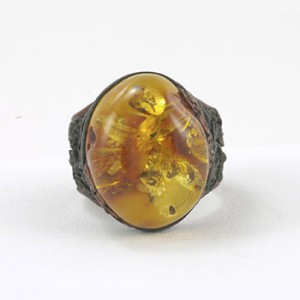 Since ancient times, people have used heating to correct the external appearance of handmade amber products inspired by the natural phenomena which generated the clear intense hue of this stone.
Since ancient times, people have used heating to correct the external appearance of handmade amber products inspired by the natural phenomena which generated the clear intense hue of this stone.
During Ancient Roman times, the production center found in Aquilea used to clarify and tint amber nuggets, and the technique was later promoted in workshops of amber artists near the Baltic Sea. Their skills and artistic ingenuity is still unrivalled. Each craftsman had his own recipe for improving amber's colors, hues and aspects. The process itself was mild and achieved through slow heating in liquids, oils and loose materials such as sand and salt.
All that changed in the second half of the 20th century, when an effective, yet risky tool appeared and eased the process: the pressure furnace of inert gas such as nitrogen and argon. In the heating chamber of the furnace, amber's bubbly structure can quickly change into clear material. The bad news is that it loses the natural golden color and develops a cold watery tint so it may be below customer's expectations.
 So what happens inside the furnace chamber? The autoclave, which is the gas found in the chamber, gets into the amber's structure, with the help of pressure measuring 300 atmospheres and a temperature of 300°C. The amber's appearance and natural scent is altered in the process. The result is a clear uniform material which can be given a nice color vibe to the surface's scales and cracks with extra roasting with oxygen. Also processed in the autoclaves are raw materials with weathered layers. The weathered layer can be roasted with nitrogen in order to obtain that greenish tint through the bottom of cabochons. In some cases where blue saturation is applied on the weathered layer, an intense green color is obtained when viewing the piece through the yellowish layer. Some sellers believe this is an artificial effect, others deny it.
So what happens inside the furnace chamber? The autoclave, which is the gas found in the chamber, gets into the amber's structure, with the help of pressure measuring 300 atmospheres and a temperature of 300°C. The amber's appearance and natural scent is altered in the process. The result is a clear uniform material which can be given a nice color vibe to the surface's scales and cracks with extra roasting with oxygen. Also processed in the autoclaves are raw materials with weathered layers. The weathered layer can be roasted with nitrogen in order to obtain that greenish tint through the bottom of cabochons. In some cases where blue saturation is applied on the weathered layer, an intense green color is obtained when viewing the piece through the yellowish layer. Some sellers believe this is an artificial effect, others deny it.
Even though the benefits of using autoclaves include good clarity of the piece, permanent binding of layers in the splice, increased hardness and decreased cleavage, the majority of Polish amber manufacturers do not use this technique. They believe that the detrimental effects of autoclaves such as discoloring and scent deterioration alter too much the very essence of amber. And so they use old methods such as liquid and oil roasting, sand, salt and air-access furnaces that use slow heating techniques and subsequent cooling. Even though the final piece will have lesser degrees of clarity, it will retain the natural color of the entire amber structure.
While other organizations agree with both the roasting and pressing methods, the International Amber Association is against reconstructed amber or pressed amber, but permits manufacturers to sell products of roasted amber. Their basic principle is to preserve the initial form of the amber nugget and roasting methods do that, while pressing techniques destroy the initial amber form.
In terms of Baltic amber identification methods, the IRS – infra-red absorptive spectroscopy - is the most reliable, but it does not state the differences between natural, improved or pressed amber stones, because all the particles remain unchanged. So when the time comes and the world runs out of raw material, this statement could become a key discussion point as to what concerns the purposefulness of using other processing methods in the future.
However, researchers say that the geological amber deposits are abundant and amber supplies will last for thousands of years, so the solution is to intensify the amber exploitation.



